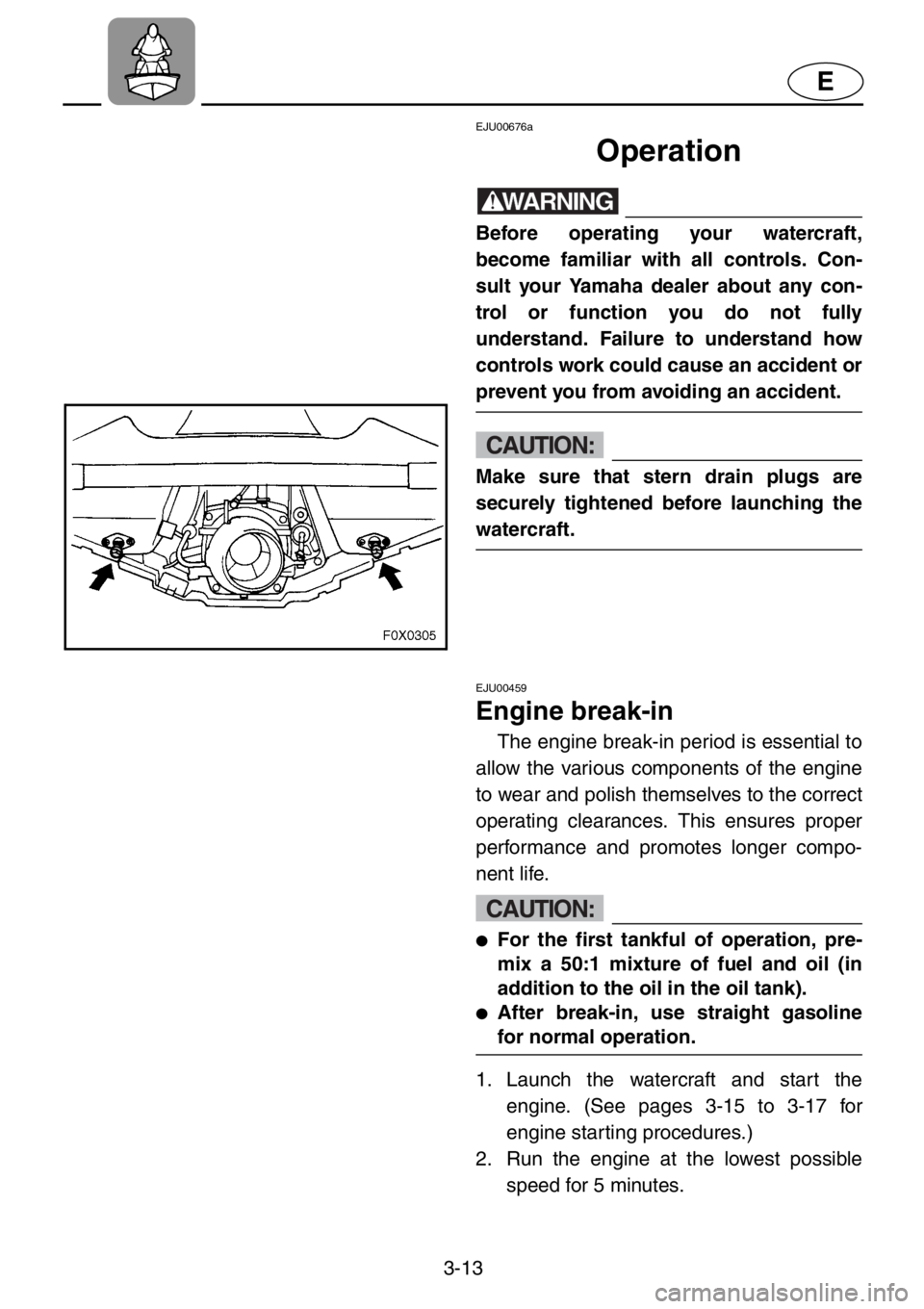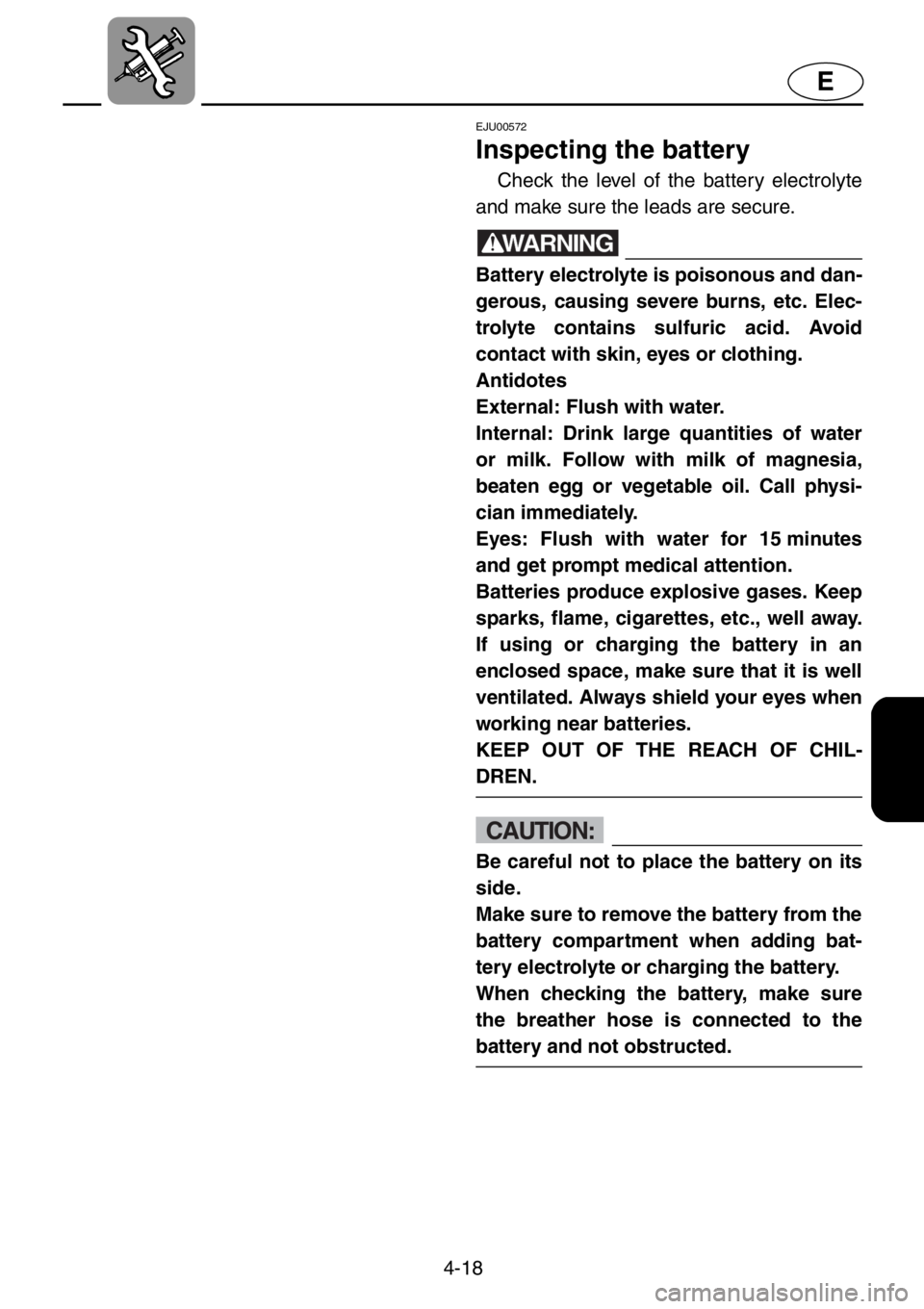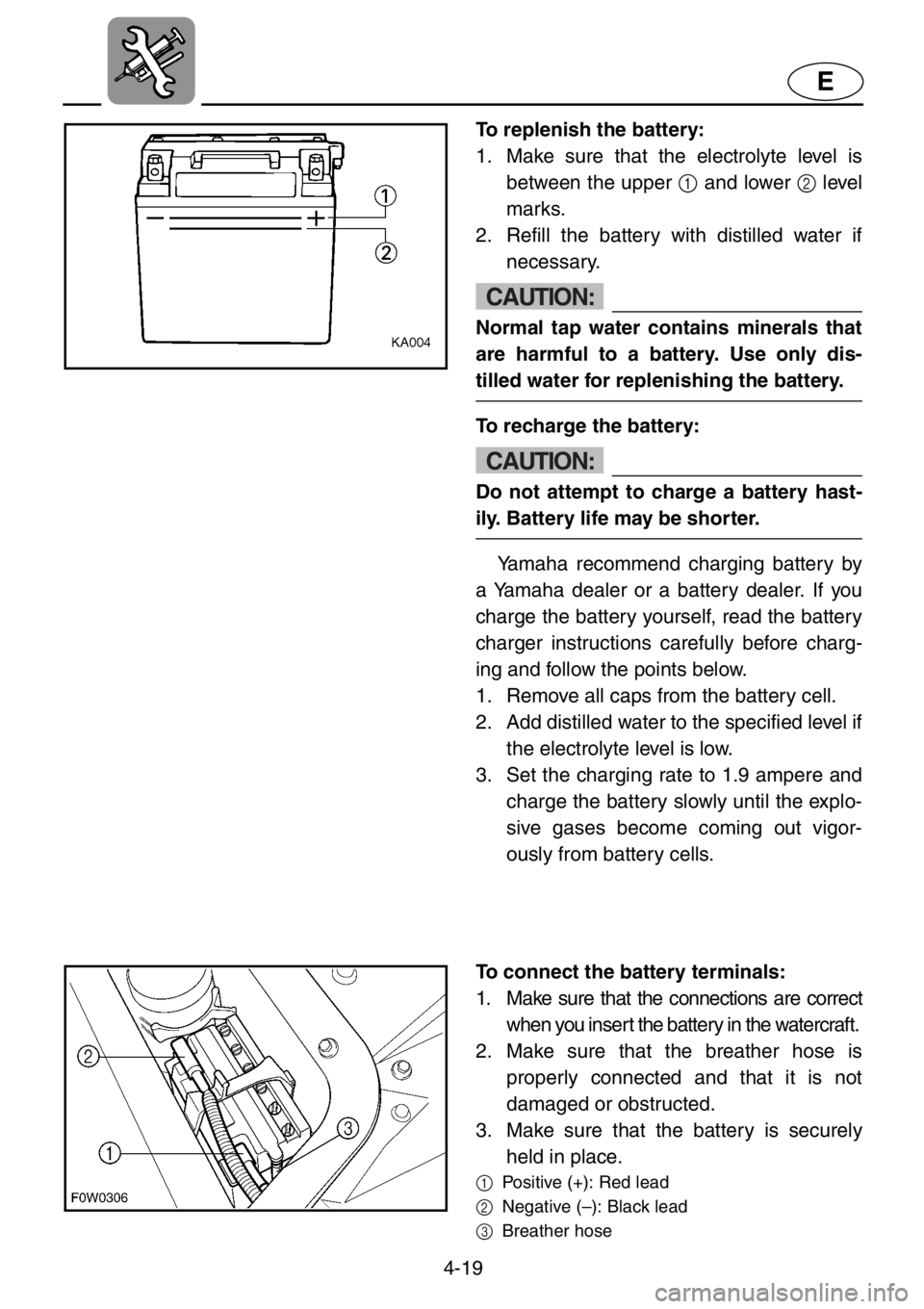Page 54 of 119
3-9
E
F0P03010
EJU00728
Fire extinguisher
Check that there is a full fire extinguisher
on board. The fire extinguisher container 1
is located in the battery compartment.
To open the fire extinguisher container
cap2 remove the seat and turn it counter-
clockwise.
After inserting the fire extinguisher make
sure that the container cap is tightened
securely.
NOTE:
●See the instructions supplied by the fire
extinguisher manufacturer for checking
the fire extinguisher. Always keep the
extinguisher in the fire extinguisher con-
tainer.
●Always carry a fire extinguisher on board.
A fire extinguisher is not standard equip-
ment with this watercraft. If you do not
have one, contact a Yamaha dealer or a
fire extinguisher dealer to obtain one
meeting the proper specifications.
Page 58 of 119

3-13
E
EJU00676a
Operation
WARNING
Before operating your watercraft,
become familiar with all controls. Con-
sult your Yamaha dealer about any con-
trol or function you do not fully
understand. Failure to understand how
controls work could cause an accident or
prevent you from avoiding an accident.
CAUTION:
Make sure that stern drain plugs are
securely tightened before launching the
watercraft.
EJU00459
Engine break-in
The engine break-in period is essential to
allow the various components of the engine
to wear and polish themselves to the correct
operating clearances. This ensures proper
performance and promotes longer compo-
nent life.
CAUTION:
●For the first tankful of operation, pre-
mix a 50:1 mixture of fuel and oil (in
addition to the oil in the oil tank).
●After break-in, use straight gasoline
for normal operation.
1. Launch the watercraft and start the
engine. (See pages 3-15 to 3-17 for
engine starting procedures.)
2. Run the engine at the lowest possible
speed for 5 minutes.
Page 69 of 119

3-24
E
F0X0319
EJU00737a
Boarding with a passenger
WARNING
Severe internal injuries can occur if
water is forced into body cavities as a
result of being near the jet thrust nozzle.
Do not apply throttle until the passenger
is seated with his or her feet on the floor
of the footwell and is holding on to the
operator.
1. Climb on board as noted in the previous
section, and sit astride the seat. Attach
the engine shut-off cord to your wrist,
and then install the clip to the engine
shut-off switch.
2. Have the passenger move to the rear of
the watercraft.
3. Have the passenger get on board and sit
on the seat.
NOTE:
When a passenger is getting on board, both
the passenger and the operator should try to
balance the watercraft.
4. The operator should check to see that
the passenger has his or her feet on the
floor of the footwell and that he or she is
securely holding on to the operator.
5. Start the engine, look in all directions,
and then accelerate to planing speed.
WARNING
Before starting off, make sure that there
are no boats, obstructions, or swimmers
around you.
Page 78 of 119
3-33
E
EJU00679
Transporting
WARNING
Always place the fuel cock knob in the
“OFF” position when transporting the
watercraft, otherwise fuel could leak out
into the engine or engine compartment,
which would create a fire hazard.
When transporting the watercraft on a
trailer, secure the tie downs to the trailer
through the bow eye and stern rope holes.
CAUTION:
Do not route ropes or tie downs over the
seat, as they may leave permanent marks
on the seat’s surface. Also, wrap the
ropes or tie downs with towels or rags
where they touch the body of the water-
craft to avoid scratching or damage.
Page 81 of 119
4-2
E
1. Put the watercraft on land in a horizontal
position.
2. Open the flushing hose connector cap 1,
and then inser t the garden hose adapter
2
into the flushing hose connector 3 and
turn it until it is securely connected.
3. Connect the garden hose adapter to a
water tap using a hose.
4. Start the engine, and then immediately
turn the water supply on until water flows
out continually from the cooling water
pilot outlet.
5. Run the engine at idling speed for about
3 minutes watching the engine condition.
If the engine stops while flushing, turn
the water supply off immediately and
repeat the above steps.
6. Turn the water supply off, and then force
the remaining water out from the cooling
passages by alternately squeezing, and
releasing the throttle lever for 10 to
15 seconds.
7. Stop the engine.
8. Remove the garden hose adapter and
secure the cap.
Page 95 of 119
4-16
E
●Throttle cable (handlebar end)
Pull the throttle lever and remove the seal 1.
Spray a rust inhibitor into the outer cable. Refit
the seal securely.
●Steering cable (handlebar end)
●Steering cable (nozzle end)
●Nozzle pivot shaft
●QSTS cable (nozzle end)
●QSTS cables (pulley end)
Page 97 of 119

4-18
E
EJU00572
Inspecting the battery
Check the level of the battery electrolyte
and make sure the leads are secure.
WARNING
Battery electrolyte is poisonous and dan-
gerous, causing severe burns, etc. Elec-
trolyte contains sulfuric acid. Avoid
contact with skin, eyes or clothing.
Antidotes
External: Flush with water.
Internal: Drink large quantities of water
or milk. Follow with milk of magnesia,
beaten egg or vegetable oil. Call physi-
cian immediately.
Eyes: Flush with water for 15 minutes
and get prompt medical attention.
Batteries produce explosive gases. Keep
sparks, flame, cigarettes, etc., well away.
If using or charging the battery in an
enclosed space, make sure that it is well
ventilated. Always shield your eyes when
working near batteries.
KEEP OUT OF THE REACH OF CHIL-
DREN.
CAUTION:
Be careful not to place the battery on its
side.
Make sure to remove the battery from the
battery compartment when adding bat-
tery electrolyte or charging the battery.
When checking the battery, make sure
the breather hose is connected to the
battery and not obstructed.
Page 98 of 119

4-19
E
To replenish the battery:
1. Make sure that the electrolyte level is
between the upper 1 and lower 2 level
marks.
2. Refill the battery with distilled water if
necessary.
CAUTION:
Normal tap water contains minerals that
are harmful to a battery. Use only dis-
tilled water for replenishing the battery.
To recharge the battery:
CAUTION:
Do not attempt to charge a battery hast-
ily. Battery life may be shorter.
Yamaha recommend charging battery by
a Yamaha dealer or a battery dealer. If you
charge the battery yourself, read the battery
charger instructions carefully before charg-
ing and follow the points below.
1. Remove all caps from the battery cell.
2. Add distilled water to the specified level if
the electrolyte level is low.
3. Set the charging rate to 1.9 ampere and
charge the battery slowly until the explo-
sive gases become coming out vigor-
ously from battery cells.
To connect the battery terminals:
1. Make sure that the connections are correct
when you insert the battery in the watercraft.
2. Make sure that the breather hose is
properly connected and that it is not
damaged or obstructed.
3. Make sure that the battery is securely
held in place.
1Positive (+): Red lead
2Negative (–): Black lead
3Breather hose